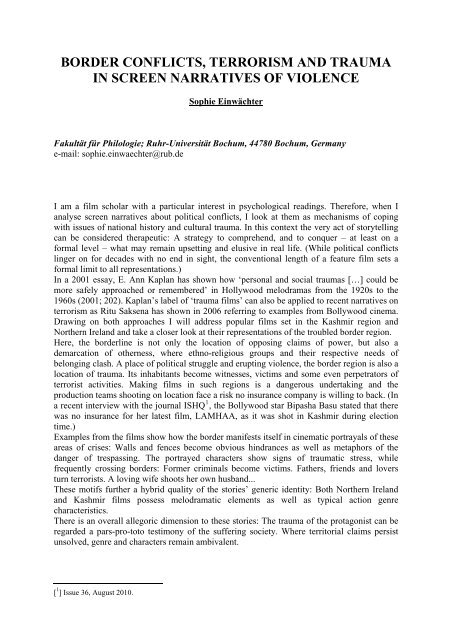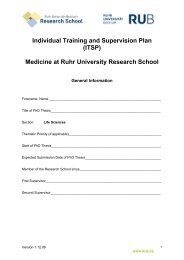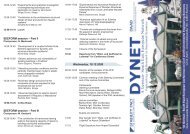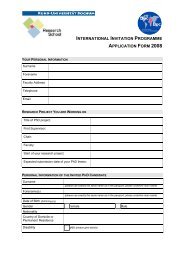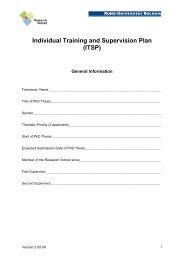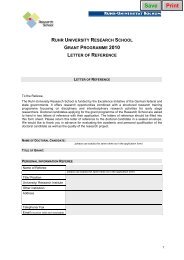Section Days abstract book 2010.indd - RUB Research School ...
Section Days abstract book 2010.indd - RUB Research School ...
Section Days abstract book 2010.indd - RUB Research School ...
Create successful ePaper yourself
Turn your PDF publications into a flip-book with our unique Google optimized e-Paper software.
BORDER CONFLICTS, TERRORISM AND TRAUMA<br />
IN SCREEN NARRATIVES OF VIOLENCE<br />
Sophie Einwächter<br />
Fakultät für Philologie; Ruhr-Universität Bochum, 44780 Bochum, Germany<br />
e-mail: sophie.einwaechter@rub.de<br />
I am a film scholar with a particular interest in psychological readings. Therefore, when I<br />
analyse screen narratives about political conflicts, I look at them as mechanisms of coping<br />
with issues of national history and cultural trauma. In this context the very act of storytelling<br />
can be considered therapeutic: A strategy to comprehend, and to conquer – at least on a<br />
formal level – what may remain upsetting and elusive in real life. (While political conflicts<br />
linger on for decades with no end in sight, the conventional length of a feature film sets a<br />
formal limit to all representations.)<br />
In a 2001 essay, E. Ann Kaplan has shown how ‘personal and social traumas […] could be<br />
more safely approached or remembered’ in Hollywood melodramas from the 1920s to the<br />
1960s (2001; 202). Kaplan’s label of ‘trauma films’ can also be applied to recent narratives on<br />
terrorism as Ritu Saksena has shown in 2006 referring to examples from Bollywood cinema.<br />
Drawing on both approaches I will address popular films set in the Kashmir region and<br />
Northern Ireland and take a closer look at their representations of the troubled border region.<br />
Here, the borderline is not only the location of opposing claims of power, but also a<br />
demarcation of otherness, where ethno-religious groups and their respective needs of<br />
belonging clash. A place of political struggle and erupting violence, the border region is also a<br />
location of trauma. Its inhabitants become witnesses, victims and some even perpetrators of<br />
terrorist activities. Making films in such regions is a dangerous undertaking and the<br />
production teams shooting on location face a risk no insurance company is willing to back. (In<br />
a recent interview with the journal ISHQ 1 , the Bollywood star Bipasha Basu stated that there<br />
was no insurance for her latest film, LAMHAA, as it was shot in Kashmir during election<br />
time.)<br />
Examples from the films show how the border manifests itself in cinematic portrayals of these<br />
areas of crises: Walls and fences become obvious hindrances as well as metaphors of the<br />
danger of trespassing. The portrayed characters show signs of traumatic stress, while<br />
frequently crossing borders: Former criminals become victims. Fathers, friends and lovers<br />
turn terrorists. A loving wife shoots her own husband...<br />
These motifs further a hybrid quality of the stories’ generic identity: Both Northern Ireland<br />
and Kashmir films possess melodramatic elements as well as typical action genre<br />
characteristics.<br />
There is an overall allegoric dimension to these stories: The trauma of the protagonist can be<br />
regarded a pars-pro-toto testimony of the suffering society. Where territorial claims persist<br />
unsolved, genre and characters remain ambivalent.<br />
[ 1 ] Issue 36, August 2010.


